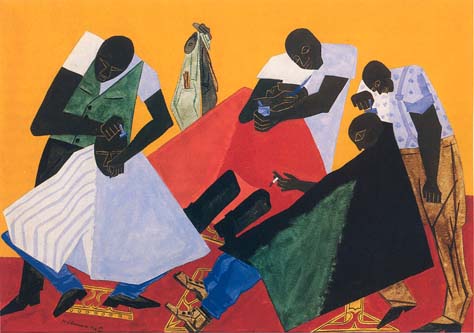Descriptive Statements:
- Demonstrate knowledge of the elements of art (i.e., color, line, shape, form, texture, value, space).
- Analyze how the elements of art have been used to achieve specific effects or communicate ideas in given works of art.
- Compare and contrast ways in which the elements of art are used in two different artworks.
- Analyze the characteristics and qualities of the elements of art in a given work of art.
Sample Item:
Use the reproduction below of Barber Shop (1946) by Jacob Lawrence to answer the question
that follows.

Each figure is portrayed in flat, bright colors and flat, nearly geometrical shapes. The center seated figure is partially obscured by the placement of the other two seated figures, and each barber is partially obscured by his client.
Source: Lawrence, Jacob. Barber Shop, 1946. Gouache on paper, 211⁄8" × 293⁄8"21 and 1 eighth by 29 and 3 eighths inches. Toledo Museum of Art, Toledo, Ohio, U.S.A. Copyright © 2009 The Jacob and Gwendolyn Lawrence Foundation, Seattle / Artists Rights Society (ARS), New York. Photo: The Jacob and Gwendolyn Lawrence Foundation / Art Resource, NY.
In this work, the artist creates the appearance of depth of space by:
- employing linear perspective.
- manipulating color.
- overlapping shapes.
- changing values.
Correct Response and Explanation (Show Correct ResponseHide Correct Response)
C. This question requires the examinee to analyze how an element of art
has been used to achieve a specific effect. In this work, the artist overlapped shapes
so some shapes appear to be in front of other shapes, establishing the illusion of depth
in a flat picture plane.
Descriptive Statements:
- Demonstrate knowledge of the principles of design (e.g., balance, contrast, unity, variety, emphasis, harmony, repetition, rhythm, pattern, movement).
- Analyze how principles of design are used to achieve specific effects or communicate ideas in a given work of art.
- Compare and contrast how principles of design have been used in two different artworks.
Sample Item:
Use the reproduction below of Barber Shop (1946) by Jacob Lawrence to answer the question
that follows.

Each figure is portrayed in flat, bright colors and flat, nearly geometrical shapes. The center seated figure is partially obscured by the placement of the other two seated figures, and each barber is partially obscured by his client.
Source: Lawrence, Jacob. Barber Shop, 1946. Gouache on paper, 211⁄8" × 293⁄8"21 and 1 eighth by 29 and 3 eighths inches. Toledo Museum of Art, Toledo, Ohio, U.S.A. Copyright © 2009 The Jacob and Gwendolyn Lawrence Foundation, Seattle / Artists Rights Society (ARS), New York. Photo: The Jacob and Gwendolyn Lawrence Foundation / Art Resource, NY.
The repetition of shapes and diagonals in this work creates a sense of:
- radial balance.
- emphasis.
- endless space.
- rhythm.
Correct Response and Explanation (Show Correct ResponseHide Correct Response)
D. This question requires the examinee to analyze how a principle of
design has been used to achieve a specific effect. In this work, the artist created a
sense of rhythm by repeating the shapes of the figures' heads and hands and the diagonal
lines demarcating the edges of the clients' smocks and the barbers' arms.